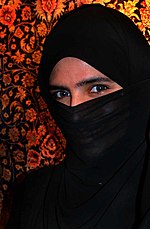Types of hijab: Difference between revisions
Appearance
Content deleted Content added
Radagast83 (talk | contribs) Removed merge tag based on discussion |
|||
| Line 51: | Line 51: | ||
{| class="wikitable" |
{| class="wikitable" |
||
<tr><th>{{unicode|Iḥrām}}</th><td>''no image''</td><td>The name typically used to denote the clothing worn by a pilgrim during either the [[Hajj]] or [[Umra]]. For a male, the first part is the ''izar'', a piece of cloth wrapped around to cover from the ankles to the abdomen. The second piece, called the ''reda'', is draped over the shoulders to cover the upper body. The cloth is to be plain, white and unsewn. For women, typical and unpretentious clothes will be their ''iḥrām''.[http://home.tiscali.nl/willemvogelsang/Exhibitions/hajjexhibition.digital/hajj.ihramdress/ihram.dress/hajj.ihramdress.Woman.htm]</td></tr> |
<tr><th>{{unicode|Iḥrām}}</th><td>''no image''</td><td>The name typically used to denote the clothing worn by a pilgrim during either the [[Hajj]] or [[Umra]]. For a male, the first part is the ''izar'', a piece of cloth wrapped around to cover from the ankles to the abdomen. The second piece, called the ''reda'', is draped over the shoulders to cover the upper body. The cloth is to be plain, white and unsewn. For women, typical and unpretentious clothes will be their ''iḥrām''.[http://home.tiscali.nl/willemvogelsang/Exhibitions/hajjexhibition.digital/hajj.ihramdress/ihram.dress/hajj.ihramdress.Woman.htm]</td></tr> |
||
<tr><th>Turban</th><td>''no image''</td><td>Denotes a special style of wrapping cloth around the head. Turbans are wrapped in varying styles, and often an undercap is worn.</td></tr> |
<tr><th>[[Turban]]</th><td>''no image''</td><td>Denotes a special style of wrapping cloth around the head. Turbans are wrapped in varying styles, and often an undercap is worn.</td></tr> |
||
<tr><th>Kufī</th><td>''no image''</td><td>A knitted cap that covers most of the head.</td></tr> |
<tr><th>Kufī</th><td>''no image''</td><td>A knitted cap that covers most of the head.</td></tr> |
||
<tr><th>Taqiyya</th><td>''no image''</td><td>A round, sewn cotton cap. It is often embellished with embroidery.</td></tr> |
<tr><th>Taqiyya</th><td>''no image''</td><td>A round, sewn cotton cap. It is often embellished with embroidery.</td></tr> |
||
Revision as of 00:20, 26 November 2006
Sartorial hijab is a phrase used to denote garments (typically female) associated with the 'modest' dress of Muslims. It is merely one aspect of hijab that every Muslim is called to have.
The below are a list of styles found in predominately Muslim societies and commonly associated with the word 'hijab'.
Women
Men
| Iḥrām | no image | The name typically used to denote the clothing worn by a pilgrim during either the Hajj or Umra. For a male, the first part is the izar, a piece of cloth wrapped around to cover from the ankles to the abdomen. The second piece, called the reda, is draped over the shoulders to cover the upper body. The cloth is to be plain, white and unsewn. For women, typical and unpretentious clothes will be their iḥrām.[3] |
|---|---|---|
| Turban | no image | Denotes a special style of wrapping cloth around the head. Turbans are wrapped in varying styles, and often an undercap is worn. |
| Kufī | no image | A knitted cap that covers most of the head. |
| Taqiyya | no image | A round, sewn cotton cap. It is often embellished with embroidery. |
| Kuffiyya, Ghutra or Smagh | no image | A checkered scarf often tied with igal. Can be styled into a turban or worn loosely over the head. |
| Igal | no image | A part of the headdress for men. Often they are made of a black rope-like cord. They are worn atop the head to help keep the ghutra secured. |
| Thawb | no image | Or "thobe", is a long, robe-like garment. Often they are white, symbolising purity and light. |
| Bisht | no image | A loose robe worn over a thawb. |
| Salwār qamīz | no image | A long shirt (qamīz) worn with trousers (salwār); it is typical of men from the sub-continent. |


